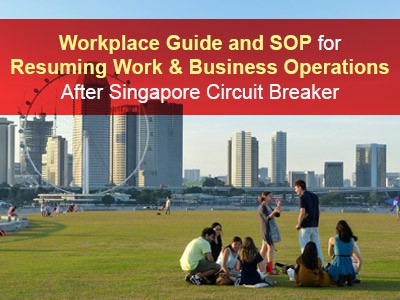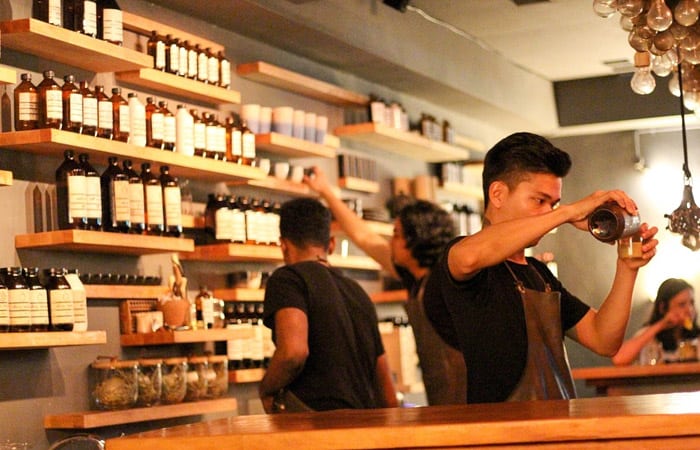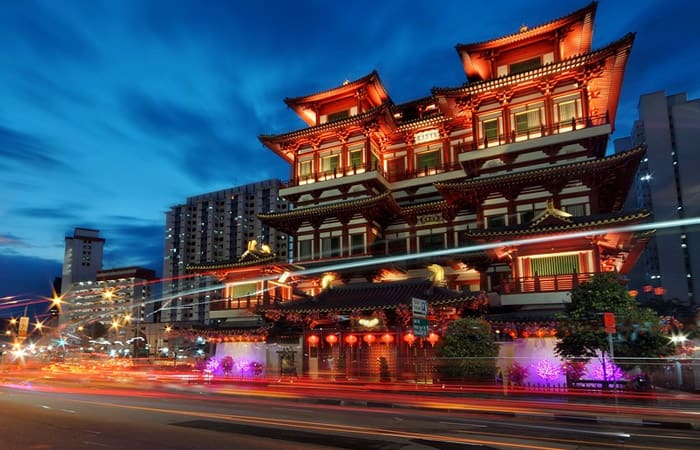Workplace Guide and SOP for Resuming Work & Business Operations After Singapore Circuit Breaker That Must Be Comply
What Will Be Considered the New “Normal” Once Measures Are Lifted
 Resuming work and business operations in Singapore after the circuit breaker period will be done in a careful manner. Workplace guidelines and SOPs will be in place and everyone is expected to adhere to these for the safety of the community. This article provides information about Workplace Guide and SOP For Resuming Work & Business Operations After Singapore Circuit Breaker.
Resuming work and business operations in Singapore after the circuit breaker period will be done in a careful manner. Workplace guidelines and SOPs will be in place and everyone is expected to adhere to these for the safety of the community. This article provides information about Workplace Guide and SOP For Resuming Work & Business Operations After Singapore Circuit Breaker.
Further measures will be announced this month by the Ministry of Finance about helping businesses and people as the COVID-19 situation continues. The Singapore Government previously announced measures to support businesses, workers and the community during the Unity Budget Speech in February. The Resilience Budget was delivered in March and the Solidarity Budget in April.
The daily number of cases in Singapore has dropped to single digits during the last few days. However, the Government is expecting a rise in cases as Singaporeans slowly begin resuming work after the circuit breaker period beginning 2 June.
New COVID-19 Cases Reported on 19 May
We’re not out of the woods yet as 451 new cases were reported on 19 May. This takes the country’s new total to 28,794 cases. 450 cases of the reported cases are among work permit holders. These workers reside in foreign worker dormitories. New cases are being reported here because of the extensive testing being conducted on these premises. The tests are part of the procedure to test and verify the status of all workers residing there.
A 30-year old Singaporean man is one of the new cases reported. He is a household contact of a Singaporean woman. The woman, who works at the Bishan MRT Station, went to work after experiencing an onset of symptoms. She is a service ambassador for the MRT’s Circle Line. She tested positive for the virus.
99% of the new cases reported are connected to known clusters. New cases reported in the community have decreased from the previous average of 6 per day to now 3 per day. Reported unlinked cases have dropped from 2 per day to an average of one a day. Singapore’s Ministry of Health (MOH) continues monitoring the existing clusters, keeping an eye out for more transmissions.
The NCS Hub and CitiWall clusters are now closed since no new cases have been linked to it. The number of recovered patients is now more than 10,000. The number of confirmed cases in hospital is 1,004. The number of cases in intensive care or critical condition sits at 10. To date, the number of COVID-19 deaths in the country stands at 22 cases.
With the risk of resurgence still high, the planned exit from the circuit breaker period on 1 June will see measures lifted progressively. Only activities that don’t involve a high risk of transmission will be resuming first.
Safety Measures During Phase 1
Economic activities will be the first to resume if they are not considered high-risk. They will commence operations on 2 June. During this period, eateries will only provide takeaway service. Several shops will stay closed at this point.
Students can go back to school, but only a portion of them. Some cohorts will be alternating between going to school for lessons and learning at home. This will happen after the circuit breaker exit on 1 June.
Singapore will only transition to Phase 2 if the transmission rates among the community remain low. The situation must stay under control for the next several weeks before the next phase can be implemented. Phase 2 will see more activities gradually resuming.
However, this could take up to four weeks as two observation periods need to be observed. Each stage of the incubation period is 14 days. Therefore, at least 28 days of observation are needed before the more measured can be relaxed. The number of COVID-19 cases in foreign worker dormitories must also be under control before moving to Phase 2.
Employers should continue to allow their staff to work from home where possible. The Government will continue monitoring the situation. Depending on how things go, it is hopeful students can fully go back to schools and higher learning institutions to learn on campus. Recreation, outdoor facilities and sports centres will be subjected to safe management measures for all once they reopen.
The resumption of activities needs to be done in a calibrated and careful manner. Precautions must be taken to avoid a spike in cases again. Singaporeans have made an effort to sacrifice over the last few weeks. All that hard work should not go to waste.
Preparations and Precautions for Phase 2
Businesses not included in the 1 June Phase 1 opening should prepare to resume operations in Phase 2. Some businesses must have additional measures in place before they can safely resume operations. Other business will need a new business model since it is unlikely their pre-COVID-19 activities will go back to normal.
Phase 2 will be done in stages. More businesses and firms will start opening gradually and adhere to safe management measures. These include food and beverage outlets that will allow dine-in, retail, enrichment centres, tuition centres and gyms.
What Will Be the “New Normal”?
Measures will gradually be eased until Singapore reaches Phase 3. This is expected to remain until a treatment or vaccine has been found for the COVID-19. It could be several months before this phase is reached, maybe longer. Phase 3 should see the situation in a sustainable and steady state. Some measures will remain for everyone’s safety.
Cultural, social and religious activities, along with business gatherings and evens should resume by Phase 3. However, the size of the gatherings still needs to be limited to avoid the rise of large clusters. Seniors, who are more vulnerable to the virus, will continue practice safe distancing measures. Other services that involved prolonged close contact or involve crowds in enclosed spaces should be able to open.
Business must stagger their work hours so there is less rush during peak travel periods. Since keeping a safe distance is going to be difficult on public transport, commuters are advised to wear masks. They should also avoid talking to each other or talking on their phones. Transport operators must enhance their cleaning regiments on trains and buses. Anti-microbial chemical coatings must be used on exposed surfaces regularly.
List of Activities Allowed to Resume
Resuming work for businesses will be done in stages starting from 2 June. The businesses are accompanied by the corresponding Singapore Standard Industrial Classification (SSIC) codes.
If you’re a business, the SSIC code must align with the “primary business activity” in the business registration records you have with the Accounting and Corporate Regulatory Authority (ACRA). You must ensure that your business activity is aligned with your selected SSIC code. If you’re not sure what your SSIC code is, you may log in to BizFile+. Log in with your CoprPass details to access the information.
Businesses on the list can choose to start either on or after 2 June. You will need to fulfil and comply with the stringent safe management measures in place. The list of safe management requirements and workplace guide SOP can be found here.
The following is a list of permitted services and sub-category of services that will commence after the circuit breaker period:
| Category | Sub-Category & SSIC Codes Starting with the Following Numbers |
| Administrative & Support Service |
|
| Financial Services |
|
| Health & Social Services |
|
| Fishing & Agricultural Services |
|
| Food Services (No Dine-ins) |
|
| Information & Communication Services |
|
| Professional & Technical Services |
|
| Manufacturing Services |
|
| Transport Services |
|
| Retail Trade Services |
|
| Utilities Services |
|
| Wholesale Trade Services |
|
| Other Services |
|
The sectors below are subject to sector-specific requirements:
| Sector | Requirements |
| Food Services |
|
| Information & Communications |
|
| Care Services (Animals & Pets) |
|
| Manufacturing |
|
| Wholesale Trade |
|
| Worship Places |
|
All businesses and services must comply with the safe management measures and workplace SOP. If an employee can continue to telecommute, they should continue to do so. They should only come to office if there is a genuine necessity or if a transaction requires them to be legally onsite.
Most businesses that still require consumer contact will not be operating yet to manage the risks of transmitting the virus. If your business is on the list of permitted activities, you don’t need to seek an exemption before commencing operations. However, you must submit your manpower details on the GoBusiness portal. This must be done within 2 weeks of resuming work after the circuit breaker period in Singapore. You may use the “Permissions and Manpower Declaration” button available on the GoBusiness portal starting from 26 May.
You will not receive further notifications about resuming operations. If you are unsure whether you can start operations again, visit bizfile.gov.sg and check your SSIC code. If the SSIC code is on the list of permitted activities, you can start work on 2 June. Companies that were granted exemption before 1 June will be able to start.
If your business has services or functions that are not on the list above, you should continue to suspend them until further notice. If your business needs to support one of the permitted services above but it is not on the list, apply for a General Exemption or Time-Limited Exemption. You will not be allowed to operate until you have received approval.
Freelancers must be registered with ACRA. This is a requirement unless your business is done under the full name reflected in your NRIC. If that is the case, include a description of your business and search for the corresponding SSIC code. Once you have your code, check to see if it is on the list of permitted activities.
If you are running a society or organisation that doesn’t require ACRA registration, you should contact the relevant authority regulating the activities in your sector. Any company found operating without permission face a penalty. First time offenders could face up to $10,000 in fine or imprisoned up to 6 months or both. This falls under the Covid-19 (Temporary Measures) Act. Subsequent offences may face up to $20,000 in fine or 12-months of jail time or both. Businesses who fail to submit their details via the GoBusiness portal will face the same penalty arrangements.
You will not be allowed to resume operations until you comply with the safe management requirements. The government views this seriously and you will face the same penalty above if you don’t comply. Any questions about implementing the safe management measures can be directed to Ministry of Manpower (MOM) or the Ministry of Health (MOH).
Staff returning to work don’t need to carry any documentation with them. Face-to-face meetings, for example with property or insurance agents, are not permitted unless legally required to do so.
You may read about the safety measures guide and SOP here. To read about the list of available budgets by the Singapore Ministry of Finance, see here.











